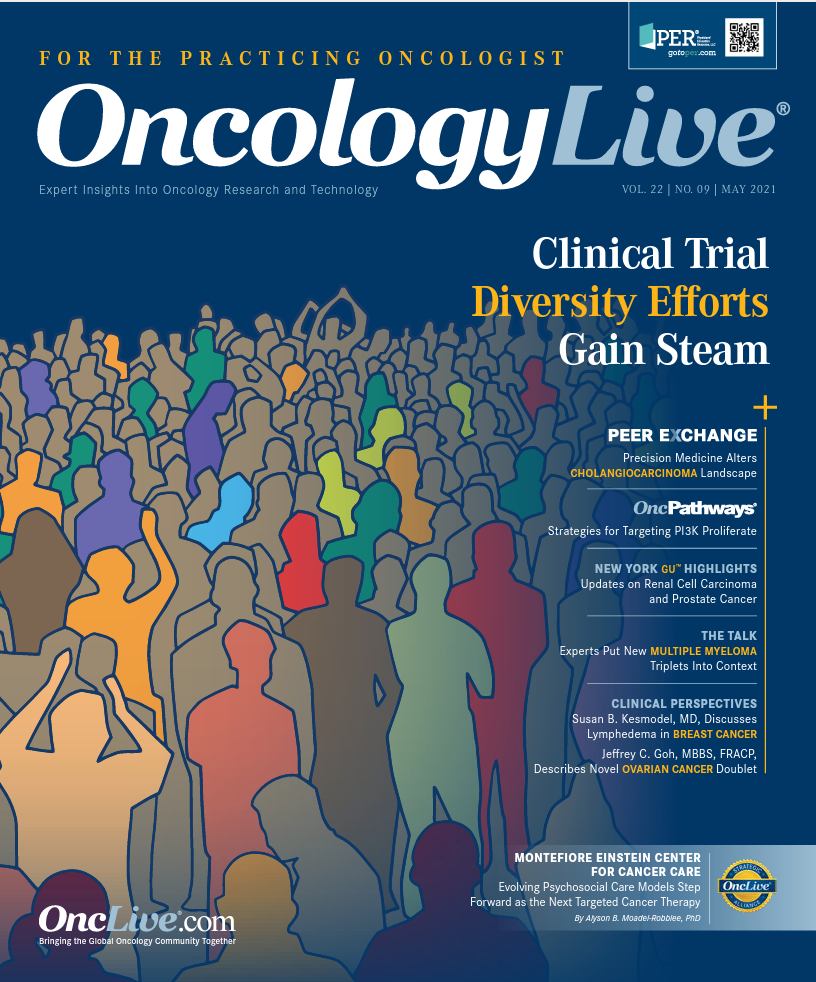TIL Immunotherapy Shows Promise as Second-Line Treatment of NSCLC
Investigators are studying LN-145, a novel immunotherapy developed from autologous tumor-infiltrating lymphocytes, as a potential new option for patients with unresectable or metastatic non–small cell lung cancer after disease progression on a checkpoint inhibitor and chemotherapy.
Kai He, MD, PhD

Investigators are studying LN-145, a novel immunotherapy developed from autologous tumor-infiltrating lymphocytes (TILs), as a potential new option for patients with unresectable or metastatic non–small cell lung cancer (NSCLC) after disease progression on a checkpoint inhibitor and chemotherapy.
The IOV-LUN-202 trial (NCT04614103) is a phase 2 registrational study of LN-145 in patients without driver mutations.
The therapy is a form of adoptive cell transfer in which TILs harvested from the patient’s tumor tissue are reinvigorated, expanded, and then infused into the patient.1,2
“This therapy is clinically relevant, and we’ve seen some people benefit from this novel immunotherapy in related clinical trials,” said Kai He, MD, PhD, a medical oncologist at The Ohio State University Comprehensive Cancer Center—The James in Columbus, as well as an assistant professor of medicine in the Thoracic Oncology Program.
“If this clinical trial is successful, this therapy would provide a relevant way to sustain response; successful development will help the patient and, we hope, convert noncurable disease to a curable one eventually.”
Although PD-1/PD-L1 immune checkpoint inhibitors (ICIs) have been incorporated into the first-line treatment paradigm as monotherapy or in combination with chemotherapy for patients with metastatic NSCLC without oncogenic mutations, most patients who receive ICIs will experience disease progression.3
The combination of pembrolizumab (Keytruda), a PD-1 inhibitor, plus chemotherapy, which is among the preferred recommendations in the National Comprehensive Cancer Network guidelines,4 is a “popular regimen,” but the majority of patients relapse within 7 to 8 months, according to Benjamin C. Creelan, MD, a medical oncologist and clinical researcher in the Department of Thoracic Oncology at Moffitt Cancer Center in Tampa, Florida.
Benjamin C. Creelan, MD

Checkpoint inhibitors may not work in some cancers because of the lack of T cells infiltrating the tumors, Creelan explained. “This trial is taking that exact population and trying an immune therapy again for them using TILs,” Creelan said.
TIL therapy has shown signs of efficacy in metastatic NSCLC. In 2020, Creelan and colleagues presented findings from a phase 1 study (NCT03215810) in which TIL therapy resulted in an ORR of 25% in 20 patients with metastatic NSCLC who had disease progression after prior treatment with nivolumab (Opdivo).5
IOV-LUN-202 Trial Details
In the IOV-LUN-202 trial, investigators are seeking to enroll 95 patients with unresectable or metastatic NSCLC who have progressed after a single line of treatment with ICI therapy plus chemotherapy with or without bevacizumab (Avastin) and whose tumors do not have an actionable driver mutation or translocation in genes such as EGFR, ALK, and ROS.1,2
To manufacture the TIL therapy, investigators will obtain a 1.5-cm sample of tumor tissue from each patient and send it to a manufacturing facility where the TILs will be reinvigorated and expanded. Prior to TIL infusion, patients will receive IV nonmyeloablative lymphodepletion with cyclophosphamide (60 mg/kg x 2) plus f ludarabine (25 mg/m2 x 5), followed by a single infusion of autologous LN-145 (day 0) and up to 6 doses of IL-2 (600,000 IU/kg).2
The IL-2 infusions are an important part of the therapy, Creelan said. “We know that the T cells that we culture still depend on those cytokines to carry out their activity when they are infused into the body,” Creelan said. “Giving patients a little extra boost afterward is believed to be important, but the amount of IL-2 and the length are up for discussion.”
The nonrandomized study will have 4 cohorts (Figure). Cohort 1 will enroll 40 patients whose tumors do not express PD-L1 prior to ICI therapy with a tumor proportion score (TPS) of less than 1%, whereas cohort 2 will enroll 40 patients with a TPS of 1% or greater before ICI therapy. Cohort 3, designed for 15 patients with a TPS of less than 1%, will use core biopsies for tumor acquisition for patients who are unable to safely undergo surgery.
Figure. LN-145 TIL Therapy in Metastatic NSCLC1,2

Cohort 4 will comprise patients who have been previously treated with LN-145 in cohort 1, 2, or 3 and who may need retreatment with the TIL therapy.
“The vast majority of patients with stage IV lung cancer will progress, even on the state-of-the-art therapy,” He noted.
The primary end point in IOV-LUN-202 is ORR using RECIST 1.1 criteria, as assessed by the independent review committee (cohorts 1 and 2) or by the investigator (cohorts 3 and 4). Secondary end points include complete response (CR) rate, duration of response (DOR), disease control rate (DCR), progression-free survival, and OS.
Investigators are recruiting patients in 50 sites in the United States and Europe. The first site was activated in January 2021.
“This is highly sophisticated, hospital-based therapy, involving surgical and nonsurgical harvesting of the TILs, isolating the TILs, proliferating, and stimulating the cells. The patient will have lymphodepletion, the infusion of TIL, and then a short course of IL-2,” He said.
Iovance Biotherapeutics, Inc, the developer of LN-145, has optimized a manufacturing process originally pioneered by the National Cancer Institute. The company can deliver a cryopreserved TIL infusion product in 16 to 22 days.2
Creelan said Moffitt Cancer Center is manufacturing the TIL therapy for the study. Meanwhile, Iovance is constructing a manufacturing facility in Philadelphia, Pennsylvania. Construction of the clean rooms was completed in late 2020, with commercial manufacturing on track to start in 2022, the company said.6
Promising Melanoma Results
Investigators also have been interested in pursuing TIL therapy for patients with NSCLC because of encouraging results in melanoma.
Most recently, at the American Association for Cancer Research Annual Meeting 2021, investigators presented findings from the phase 2 C-144-01 study (NCT02360579) involving a cohort of patients who were treated with a cryopreserved form of lifileucel (LN-144) that had been centrally manufactured in a 22-day process.7
Cohort 2 enrolled 66 patients with unresectable or metastatic melanoma who had been treated with at least 1 prior therapy including an anti–PD-1 inhibitor and, for those with a BRAF V600 mutation, a BRAF inhibitor or a combination of BRAF plus MEK inhibition. The median age of the patients was 55 years (range, 20-79) and the mean number of prior therapies in the cohort was 3.3.
After a median study follow-up of 28.1 months, the ORR among patients in the cohort was 36.4%, with 3 patients experiencing CRs and 21 exhibiting partial responses (PRs). The DCR, which includes patients with stable disease as well as responses, was 80.3%. The median DOR was not reached (range, 2.2-35.2+ months).7
The adverse event (AE) profile was consistent with the advanced disease of the participants and the safety profile of the nonmyeloablative lymphodepletion and IL-2 regimens that participants also received, investigators noted.
The incidence of treatment-emergent AEs of grade 3 or 4 severity was 97.0%, most frequently thrombocytopenia, anemia, and febrile neutropenia. Two patients died, 1 from an intra-abdominal hemorrhage possibly related to TIL therapy and the second from acute respiratory failure not associated with TILs.7
The TILs used to produce lifileucel for the study were procured from tumor tissue in numerous organ sites, showing that the therapy could be manufactured successfully regardless of the site of origin.7
Further Research Into LN-145
Investigators continue to study LN-145 in several other cancers. In head and neck squamous cell carcinoma (HNSCC), investigators are studying the immunotherapy in combination with pembrolizumab in patients with advanced recurrent or metastatic disease who have not been treated previously with ICIs. Interim results were presented in November 2020 at the 35th Anniversary Annual Meeting of the Society for Immunotherapy of Cancer.8
In cohort 2A of the phase 2 IOV-COM-202 study (NCT03645928), the response rate was 44.4%, including 1 complete response and 3 partial responses, among 9 patients with HNSCC who received a one-time TIL administration plus pembrolizumab, for a DCR of 88.9%. Median DOR was not reached at 8.6 months of median study follow-up (range, 1.0+ to 10.9+ months).8
The study is continuing to evaluate TIL therapy in 7 cohorts as monotherapy or in combination with pembrolizumab in patients with melanoma, HNSCC, or NSCLC, or in combination with nivolumab plus ipilimumab (Yervoy) in NSCLC.9
The trial will test 3 types of TIL therapy: lifileucel (LN-144)/LN-145, produced on a 22-day manufacturing schedule; a third-generation version of LN-144, manufactured in 16 days; and LN-145-S1, a PD-1–selected TIL product.9
Additionally, investigators are studying LN-145 as monotherapy and in combination with pembrolizumab in patients with metastatic cervical cancer in a phase 2 trial (NCT03108495).
References
- Autologous LN-145 in patients with metastatic non‒small-cell lung cancer. ClinicalTrials.gov. Updated April 6, 2021. Accessed April 7, 2021. https://clinicaltrials.gov/ct2/show/NCT04614103
- Massarelli E, Goldberg Z, Cacovean A, et al. Trial in progress: a phase 2, multicenter study of autologous tumor infiltrating lymphocytes (TIL, LN-145) cell therapy in patients with metastatic non-small cell lung cancer (IOV-LUN-202). Presented at: American Association for Cancer Research Annual Meeting 2021; April 10-15, 2021; virtual. Abstract CT246. https://www.abstractsonline.com/pp8/#!/9325/presentation/4856
- Horvath L, Thienpont B, Zhao L, Wolf D, Pircher A. Overcoming immunotherapy resistance in non-small cell lung cancer (NSCLC) ― novel approaches and future outlook. Mol Cancer. 2020;19(1):141. doi:10.1186/s12943-020-01260-z.
- NCCN. Clinical Practice Guidelines in Oncology. Non-small cell lung cancer, version 4.2021. Accessed April 14, 2021. https://www.nccn.org/professionals/physician_gls/pdf/nscl.pdf
- Creelan B, Wang C, Teer J, et al. Durable complete responses to adoptive cell transfer using tumor infiltrating lymphocytes (TIL) in non-small cell lung cancer (NSCLC): a phase I trial. Cancer Res. 2020;80(suppl 16). doi:10.1158/1538-7445.AM2020-CT056
- Iovance Biotherapeutics reports fourth quarter and full year 2020 financial results and corporate updates. News release. Iovance Biotherapeutics. February 25, 2021. Accessed April 7, 2021. https://ir.iovance.com/news-releases/news-release-details/iovance-biotherapeutics-reports-fourth-quarter-and-full-year-2
- Chesney JA, Larkin JMG, Kirkwood JM, et al. Lifileucel (LN-144), a cryopreserved autologous tumor infiltrating lymphocyte (TIL) therapy in patients with advanced (unresectable or metastatic) melanoma: durable duration of response at 28 month follow up. Presented at: 2021 American Association for Cancer Research Annual Meeting; April 10-15, 2021; Virtual. Abstract CT008.
- Iovance Biotherapeutics presents clinical data in head and neck cancer at Society for Immunotherapy of Cancer (SITC) 35th annual meeting. News release. Iovance Biotherapeutics. November 9, 2020. Accessed April 7, 2021. https://ir.iovance.com/news-releases/news-release-details/iovance-biotherapeutics-presents-clinical-data-head-and-neck
- Gettinger S, Kluger H, Schoenfeld A, et al. A phase 2, multicenter study of autologous tumor infiltrating lymphocytes (TIL, LN 144/LN-145/LN-145-S1) in patients with solid tumors. Presented at: American Association for Cancer Research Annual Meeting 2021; April 10-15, 2021; virtual. Abstract CT235. https://cattendee.abstractsonline.com/meeting/9325/Presentation/4844




